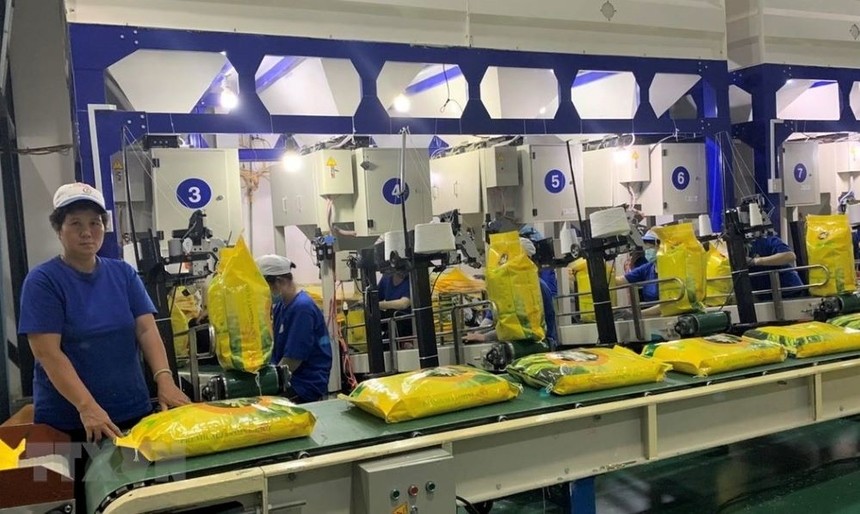Rice exports increased
Continuously receiving orders to demanding markets, Mr. Dinh Minh Tam - Director of Co May Co., Ltd. (Dong Thap) said that in the first months of the year, orders were from key markets such as Europe and Hong Kong. Kong (China) quite regularly. Accordingly, on average each month the unit exports 2 containers of rice to these markets. As for the US market , thanks to increased rice demand each year, businesses still have a lot of room to expand exports.
“The company's main export markets all grew well with high selling prices. Co May only exports rice, shrimp and ecological rice and shrimp. From the beginning of the year until now, market conditions and market share growth have been good, selling prices are high at over 1,000 USD/ton," Mr. Tam said.
Giving more information about the advantages in rice export in the first 4 months of the year, Ms. Huynh Thi Bich Huyen - Director of Ngoc Quang Phat Import-Export Joint Stock Company, shared that in 2024, rice export will have many advantages when it comes to orders. more, the selling price also tends to increase. Currently, demand from markets such as the Philippines and Indonesia is still increasing.
 |
| Rice export still faces many challenges |
The latest report from the Ministry of Agriculture and Rural Development, as of the end of April this year, Vietnam exported 3.23 million tons of rice, with a turnover of 2.08 billion USD. Compared to the same period last year, rice exports increased 11.7% in volume and increased sharply by 36.5% in value.
In April 2024, the average export price of rice reached 623 USD/ton, down 1.3% compared to March but still up 19.2% over the same period in 2023. Overall, in the first 4 months of this year, export prices The average rice export remained high, at 644 USD/ton, up 22.2% over the same period last year.
Data from the Vietnam Food Association shows that, after a period of decline, export rice prices are recovering. Accordingly, Vietnam's export price of 5% broken rice is anchored at 580 USD/ton, equivalent to the price of Thai rice of the same type and 10 USD/ton higher than Pakistani products.
Commenting on the rice market in the second quarter of 2024, the Vietnam Food Association assessed that world rice prices and Vietnam's export rice prices will remain high. The reason is that the world's rice supply is still limited due to adverse weather conditions, many major supplying countries are forced to ban and limit exports. Meanwhile, the world's largest rice exporter, India, has not lifted the ban on white rice exports since the middle of last year. Thailand will also cut rice exports to ensure domestic food security.
Face many challenges
Despite recording high results, according to rice export experts, they are still facing many challenges. Mr. Nguyen Ngoc Nam - Chairman of the Vietnam Food Association said that the biggest challenge today is weather fluctuations. Along with that, there are economic and political risks in the world that make the rice market unpredictable, and constantly increasing transportation costs also cause businesses' costs to increase. In addition, credit issues are also of concern to the rice export trading community.
Sharing about the difficulties, Mr. Dinh Minh Tam - Director of Co May Co., Ltd. (Dong Thap) said that the continuous fluctuation of domestic and world rice prices in recent times has caused businesses to face many challenges in their business. manufacturing business.
According to Mr. Tam, the business has linked with farmers to build raw material areas for rice and shrimp, ecological rice and shrimp... Previously, domestic rice prices were flat and less volatile, trading between businesses and people took place. came out quite conveniently. However, from August 2023 until now, domestic rice prices have continuously fluctuated, making businesses unable to calculate the future. “The contract was signed with the customer in advance, but when rice prices continue to increase, businesses will have to buy rice at high prices. Meanwhile, businesses cannot increase prices, because if they increase prices, they will lose customers and lose the market. Rice price fluctuations cause chain links to be completely broken," Mr. Tam said.
Also according to Mr. Tam, the broken chain link makes businesses afraid to invest in seeds in the new crop. Because when the seed investment is completed and harvest time comes, the price increases and people sell it outside. These are risks that affiliated businesses will encounter in the near future.
Like other industries, rice business must follow market supply and demand. Therefore, Mr. Tam said that local authorities need to pay attention and support businesses in building raw material areas. “Localities must coordinate with cooperative groups to encourage people to share benefits with businesses so that people can profit and businesses have goods. From there, businesses can boldly invest and sustainably develop raw material areas," Mr. Tam said.



